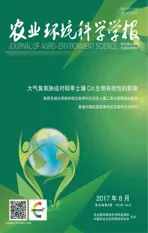不同类型土壤淹水对pH、Eh、Fe及有效态Cd含量的影响
2017-09-03朱丹妹刘岩张丽王秀梅安毅李玉浸林大松
朱丹妹,刘岩,张丽,2,王秀梅,安毅,李玉浸,林大松*
(1.农业部环境保护科研监测所,天津 300191;2.东北农业大学资源与环境学院,哈尔滨 150030)
不同类型土壤淹水对pH、Eh、Fe及有效态Cd含量的影响
朱丹妹1,刘岩1,张丽1,2,王秀梅1,安毅1,李玉浸1,林大松1*
(1.农业部环境保护科研监测所,天津 300191;2.东北农业大学资源与环境学院,哈尔滨 150030)
基于数据收集整理,分析了南方不同酸碱性土壤淹水后,土壤pH值、Eh值、Fe[Fe(Ⅱ)和无定型氧化铁]含量、有效态Cd含量和不同有机质土壤淹水后有效态Cd含量变化趋势,同时分析了pH、Eh、Fe变化趋势对有效态Cd含量的影响。结果表明:不同酸碱性土壤长时间淹水后,pH均趋于中性、Eh下降、Fe含量增加;有效态Cd含量在酸性和中性土壤中呈持续下降趋势,分别降低了42%和38%;在碱性土壤中降低了27%,其中淹水前15 d呈增加趋势,淹水15 d后逐渐减少。不同有机质含量土壤淹水后,有效态Cd含量在中高(≥20 g·kg-1)有机质土壤中降低78%,且为持续降低趋势;在中低(≤20 g·kg-1)有机质土壤中降低了52%,在淹水15~30 d增加,且淹水15 d有效态Cd含量要低于淹水60 d有效态Cd含量。土壤有效态Cd含量随着pH值增大而降低,且变化速率一致,即pH值增加速率大时,有效态Cd含量降低速率也大,反之亦然;土壤有效态Cd含量在淹水前15 d随Fe含量的增加而增加,淹水15 d后随着Fe含量增加而降低;整个淹水期间,土壤有效态Cd含量随着Eh值降低而降低。综上,酸性土壤和中高有机质土壤淹水后可有效降低土壤有效态Cd含量,碱性土壤淹水时间不低于30 d、中低有机质土壤淹水不超过15 d才能达到有效降低土壤有效态Cd含量之目的。
pH;Eh;Fe;有效态Cd;淹水时间
Cd是一种痕量有毒重金属,易被作物特别是水稻吸收,并通过食物链转移至人体,对人体健康造成危害。我国耕地土壤重金属污染不容忽视,特别是南方地区尤为严重,根据《全国土壤污染状况调查公报》[1],我国耕地土壤Cd污染以轻微、轻度污染为主,但总体点位超标率高于其他重金属,达7%。目前,重金属污染土壤的修复治理已越来越受到人们的重视,研究表明,对于重金属轻度污染的土壤,通过灌溉及农艺措施调控即可达到安全生产的目的。
土壤淹水作为一种调控措施,在淹水还原作用下,无论酸性土壤还是碱性土壤,其pH值均会趋于中性[2-3],且Eh值下降[4-5],Fe(Ⅱ)及无定型氧化铁含量增加[6-7]。土壤这些性质的变化可间接影响土壤Cd的生物有效性,Cd形态会重新分配,由交换态转化成碳酸盐结合态、铁锰氧化物结合态和有机物结合态,从而降低土壤Cd活性[8-9]。Kitagishi等[10]和Gambrell 等[11]报道,淹水条件下Cd溶解度随土壤Eh值降低而减小,低Eh值条件有利于CdS沉淀的生成。郑绍建等[12]对稻田水旱轮作各时段土壤Cd形态(交换态、有机结合态、碳酸盐结合态、氧化锰结合态、氧化铁结合态、残渣态)进行了连续测定,结果表明稻田淹水后土壤pH值增大,有机质和铁锰氧化物对Cd的吸持能力增强。这是土壤Cd生物有效性降低的主要原因。Kasheln等[9]进行的土壤淹水培养试验表明,铁锰氧化物还原溶解形成的新铁锰氧化物对Cd的吸持是导致Cd活性下降的主要原因。Bolton等[13]通过对7种土壤化学特性和Cd吸附容量回归分析,认为土壤对Cd的吸附容量与土壤中铁氧化物的含量密切相关,而土壤中铁氧化物的还原溶解受土壤pH和Eh的影响。Mustafa等[14-15]通过批量试验研究了Cd在a-FeOOH上的吸附-解吸过程,结果表明,Cd在a-FeOOH表面的吸附量随着pH值的升高而增加;淹水后随着水土体系Eh值降低,铁氧化物还原溶解,新生成的无定形或微晶形结构氧化铁具有更多吸附点位和更大的比表面积,极大提高了对Cd的吸附能力,致使土壤中Cd的移动性极大降低[16-17]。
本研究通过文献检索与数据分析,对淹水期间土壤pH值、Eh值和Fe、有效态Cd含量数据进行收集整理,分析了淹水期间不同酸碱性土壤中pH值、Eh值和Fe、有效态Cd含量的变化情况,为更有效地通过淹水治理土壤Cd污染提供理论依据。
1 材料与方法
1.1 数据收集
本文收集的数据主要为Cd污染相对严重的南方水稻土试验数据。鉴于已有研究表明,土壤pH、Eh、有机质、阳离子交换量(CEC)、土壤质地等对土壤Cd活性具有较大影响,本文主要收集了国内主要期刊2003—2013年间发表的有关土壤淹水试验条件下的土壤pH值、Eh值和Fe含量、有效态Cd含量数据(表1)。数据来源:源文献直接指出;通过源文献中趋势图摘出;通过源文献给出的数学式计算。
这些文献主要为室内恒温(20~30℃范围)条件下进行全程土壤淹水培养实验。由于各实验目的不同,测定指标也不尽相同,在同一篇文献中很难收集到土壤pH、Eh、Fe、有效态Cd的所有数据,因此选择原则定为:只要包括淹水条件下土壤pH、Eh、Fe、有效态Cd等指标中一种指标的测定数据即可。

表1 样本数据Table 1 Sample data
1.2 数据处理
1.2.1 土壤酸碱性及有机质分类
参考郑红艳等[18]对土壤类型分类依据,将收集到的土壤数据按pH值大小分为酸性(pH 6.5以下)、中性(pH 6.5~7.5)和碱性(pH 7.5以上)。因收集土壤有机质含量总体在9~49 g·kg-1之间,处于中、高含量范围,且受Cd数据量的限制,以中等有机质含量(10~30 g·kg-1)的中间值20 g·kg-1为分界线,把有机质分为中低含量(有机质含量≤20 g·kg-1)和中高含量(有机质含量≥20 g·kg-1)两组。
1.2.2 数据样本数量一致性
因pH、Eh、Fe、有效态Cd数据样本数量差异,故在对数据作图分析时均采用平均数进行分析讨论。
1.2.3 土壤Cd、Fe数据处理
有效态Cd为水溶态和交换态两种形态,Fe为土壤中的二价铁离子和无定型氧化铁两种活性较高的形态。由于形态不同,对Cd、Fe数据进行lg10处理转化,转化后有效态Cd含量单位为lg(mg·kg-1),Fe含量单位为lg(g·kg-1)。
采用SPSS 2.0和Excel进行数据统计分析。
2 结果分析
2.1 不同酸碱性土壤淹水后土壤pH、Eh、Fe含量、有效态Cd含量变化
淹水前土壤理化性质见表2。不同酸碱性土壤淹水对土壤pH值的影响(表3)表明:淹水15 d内土壤pH值变幅较大,酸性土壤pH值呈持续增加趋势,碱性土壤pH值呈持续减小趋势;中性土壤在整个淹水期间pH值在7附近波动。淹水15 d后,pH值基本都趋于平稳,且趋于中性。淹水60 d后土壤pH值变幅依次为碱性土壤>酸性土壤>中性土壤。不同酸碱性土壤淹水后,变化趋势为酸性土壤pH值增大,碱性土壤pH值减小,最终均趋于中性。
不同酸碱性土壤淹水对土壤Eh的影响表明(表3):土壤Eh值在整个淹水期间均持续降低,其中酸性土壤淹水60 d后Eh值降低了314,中性土壤降低了292,碱性土壤降低了342,降低幅度表现为碱性土壤>酸性土壤>中性土壤。
不同酸碱性土壤淹水对土壤Fe含量的影响表明(表3):土壤淹水后,土壤中Fe含量均呈增加趋势,其中酸性、中性和碱性土壤淹水60 d后分别增加了2.16、0.14、0.59 g·kg-1,酸性土壤中Fe含量增加幅度最大。酸性土壤Fe含量在淹水1~30 d呈增加趋势,淹水30 d后逐渐减小;中性土壤在整个淹水期间Fe含量变化幅度较小;碱性土壤Fe含量仅在淹水1~5 d急速增长,随后变化趋于平稳。
不同酸碱性土壤淹水对土壤有效态Cd含量的影响表明(表3):土壤淹水后,土壤有效态Cd含量均有所降低,其中酸性、中性和碱性土壤有效态Cd含量淹水60 d后分别降低了42%、38%和27%,说明淹水前pH值越大的土壤,淹水后土壤有效态Cd含量降低幅度越小。酸性土壤有效态Cd含量在淹水1 d后快速降低,随后随淹水时间呈平缓降低趋势;中性土壤有效态Cd含量在淹水5 d内有一个快速增加随后快速降低的过程,淹水5 d后呈平缓下降趋势;碱性土壤有效态Cd含量在淹水15 d内呈增加趋势,淹水15~30 d开始下降,淹水30~60 d变化相对平缓。由此可见,酸性土壤在淹水条件下土壤有效态Cd含量降低幅度最大,且呈持续降低趋势;由表3可以看出,碱性土壤淹水30 d有效态Cd含量才低于淹水前,因此对于碱性土壤淹水时间应不低于30 d。
2.2 不同有机质含量土壤淹水后有效态Cd含量变化
图1为在淹水60 d期间,有效态Cd含量在中低[2,20,27,36,40]和中高[3,19-20,26,28,32,40]有机质含量土壤中的变化。
在中低有机质含量土壤中,有效态Cd含量(y= 0.000 1x2-0.009 5x-2.584 5,R2=0.576 2,N=9)在淹水15~30 d呈增大趋势,其他淹水时间有效态Cd含量降低,淹水60 d后降低了56%。在中高有机质含量土壤中,有效态Cd含量(y=-0.010 2x-2.713 2,R2= 0.838 4,N=10)呈线性降低的趋势,淹水60 d后降低了78%。淹水第1 d,有效态Cd含量在两种不同有机质含量土壤中降低速率均为最大,降低速率都达到了34%;随着淹水时间的延长,两种不同有机质含量土壤中有效态Cd含量变化趋势不同,在中低有机质含量土壤中,淹水1~30 d期间,土壤有效态Cd含量先降低后升高,而中高有机质含量土壤中,在淹水1~30 d期间,土壤有效态Cd含量呈现不断降低的趋势。与淹水前相比,在淹水30~60 d期间,有效态Cd含量在中低和中高两种不同有机质含量土壤中分别降低了7%和14%。
综上,中高有机质含量土壤淹水后有效态Cd含量降幅最大,且为持续降低;中低有机质含量土壤淹水后有效态Cd含量降幅相对较小,在淹水15~30 d为增加趋势,且淹水15 d土壤有效态Cd含量为1.78 mg·kg-1,低于淹水60 d土壤有效态Cd含量。这表明对于中低有机质含量土壤,淹水15 d土壤有效态Cd含量降低效果为最佳。
2.3 不同淹水时间土壤pH、Eh、Fe与有效态Cd之间的关系
2.3.1 土壤pH与有效态Cd含量之间的关系
图2为淹水60 d期间土壤pH值与有效态Cd含量的变化趋势,所选择的文献均同时包含pH值和有效态Cd含量两个指标数据[2,3,19-20,26-28,32,36,40]。
在整个淹水期间,土壤有效态Cd含量呈线性降低趋势(y=-0.047 8x-2.901 8,R2=0.91,N=19),而pH值呈线性上升趋势(y=0.041 3x+6.304 8,R2=0.96,N= 19),说明土壤有效态Cd含量随着pH值增大而降低。土壤pH值在淹水60 d后增加了0.19个单位,土壤有效态Cd含量在淹水60 d后降低了42%。在淹水前5 d,土壤pH值增幅最大,平均每天增加0.02个单位,土壤有效态Cd含量在此期间降低速率最大,平均每天降低2%。在淹水5~15 d和淹水15~30 d期间,土壤pH值增加速率基本一致,平均每天增加0.003个单位,土壤有效态Cd含量平均每天降低0.43%和1.40%;在淹水30~60 d,土壤pH值增加0.01个单位,而土壤有效态Cd含量平均每天的降低速率为0.38%。
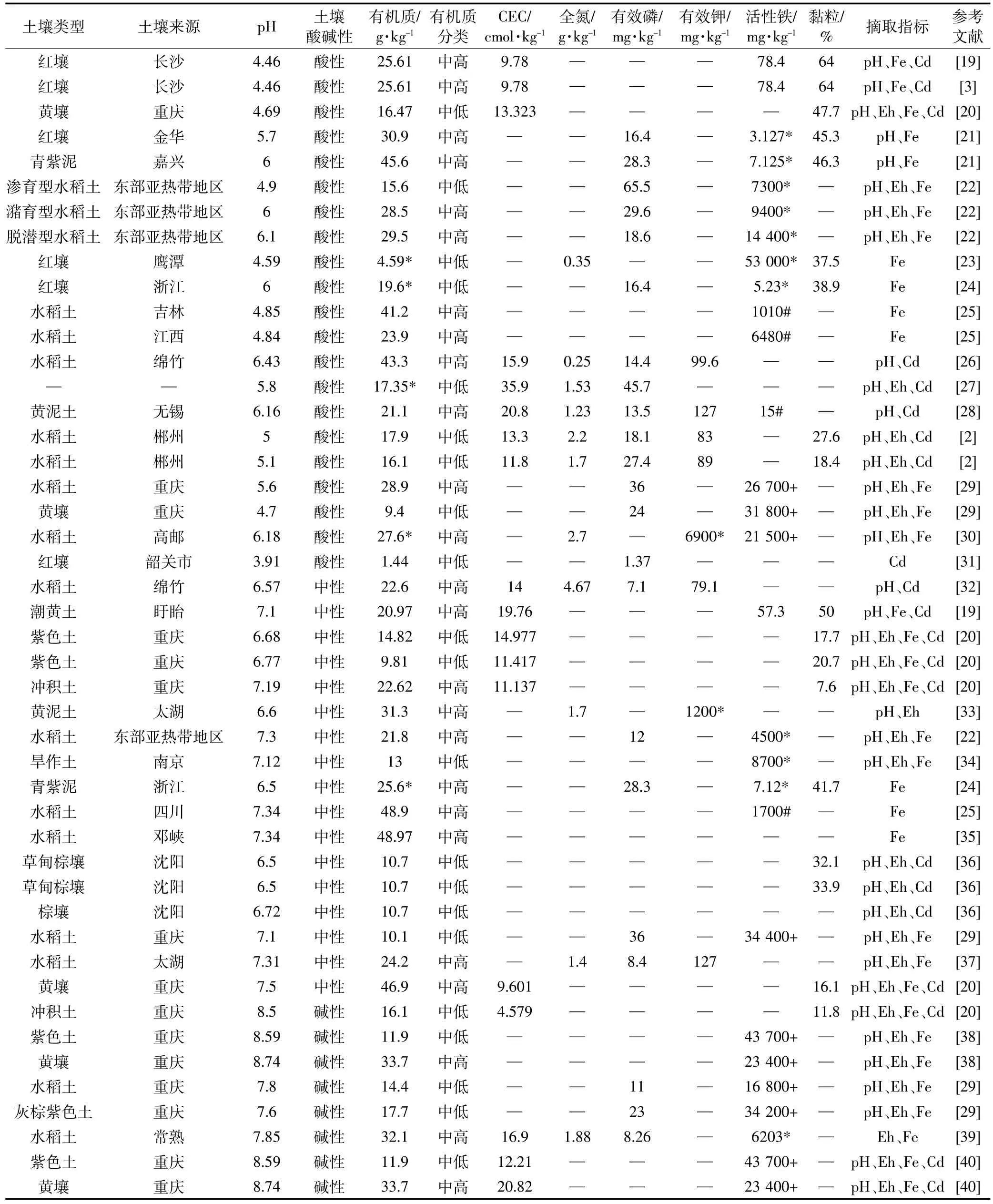
表2 淹水前土壤基本理化性质Table 2 Soil properties before experiment
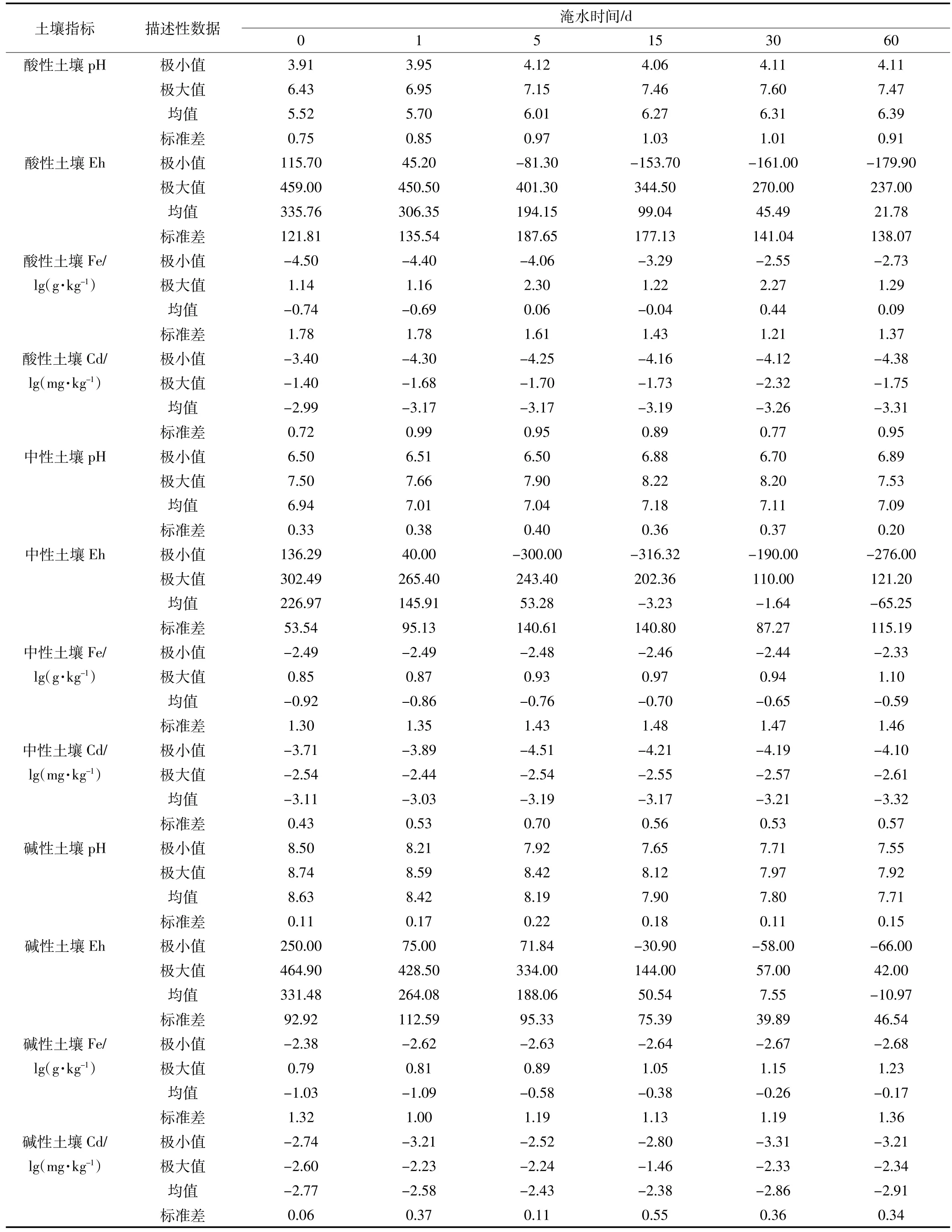
表3 土壤pH、Eh、Fe、有效态Cd在不同淹水时间描述性数据Table 3 Descriptive data of soil pH,Eh,Fe and available Cd in different flooding time

图1 不同淹水时间有效态Cd含量在中低和中高有机质土壤中的变化Figure 1 The variation of available-Cd content in middle-low and middle-high organic soil in different flooding time
总体来看,随着淹水时间的延长,土壤pH值的增加速率和土壤有效态Cd含量的降低速率均变得缓慢。由此可见,淹水后土壤有效态Cd含量与pH值变化方向相反,且变化速率一致,即pH值增加速率大时,有效态Cd含量降低速率也大,pH值增加速率降低时,有效态Cd含量降低速率也随之降低。
2.3.2 土壤Eh与有效态Cd含量之间的关系
图3为淹水60 d期间土壤Eh值与有效态Cd含量的变化趋势,所选择的文献均同时包含Eh值和有效态Cd含量两个指标数据[2,20,27,36,40]。
由图3可以看出,在整个淹水期间土壤有效态Cd含量呈线性下降趋势(y=-0.045x-2.617 2,R2= 0.855 3,N=12),土壤Eh值在整个淹水期间同样呈线性下降趋势(y=-61.84x+287.84,R2=0.934 8,N=12),说明土壤有效态Cd含量随土壤Eh值降低而降低。淹水60 d后土壤Eh值降低了126%,土壤有效态Cd含量降低了38%。
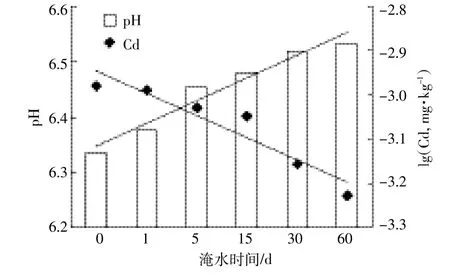
图2 不同淹水时间土壤pH值与有效态Cd含量之间的关系Figure 2 The relations between soil pH and available-Cd content in different flooding time
淹水第1 d,Eh值降低速率最大,降低了45%,土壤有效态Cd含量降低速率亦最大,降低了5%。淹水5~60 d期间,土壤Eh与土壤有效态Cd含量均呈现持续降低的趋势,随着淹水时间的延长降低速率趋于缓慢。
2.3.3 土壤Fe含量与有效态Cd含量之间的关系
图4为淹水60 d期间土壤Fe含量与有效态Cd含量的变化趋势,所选择的文献均同时包含Fe和有效态Cd含量两个指标数据[3,19-20,40]。
在整个淹水期间,土壤Fe含量呈线性增大趋势(y=0.221 7x-2.595 9,R2=0.933 8,N=11),而土壤有效态Cd含量(y=-0.018 9x2+0.060 2x-2.722,R2=0.855 8,N=11)呈现先增加后降低的趋势。在淹水第1 d,Fe含量增加49%,有效态Cd含量降低了24%,有效态Cd含量降低速率为整个淹水期间最大。在淹水1~5 d和淹水5~15 d,Fe含量与淹水第1 d相比,分别增加了3倍和4倍;而土壤有效态Cd含量在淹水1~15 d呈增大趋势,与淹水第1 d相比增加了15%。在淹水15~30 d,Fe含量平均每天增加速率为3%,土壤有效态Cd含量平均每天降低3%;在淹水30~60 d,Fe含量平均每天增加0.4%,土壤有效态Cd含量平均每天降低0.7%。

图3 不同淹水时间土壤Eh值与有效态Cd含量之间的关系Figure 3 The relations between soil Eh values and available-Cd content in different flooding time
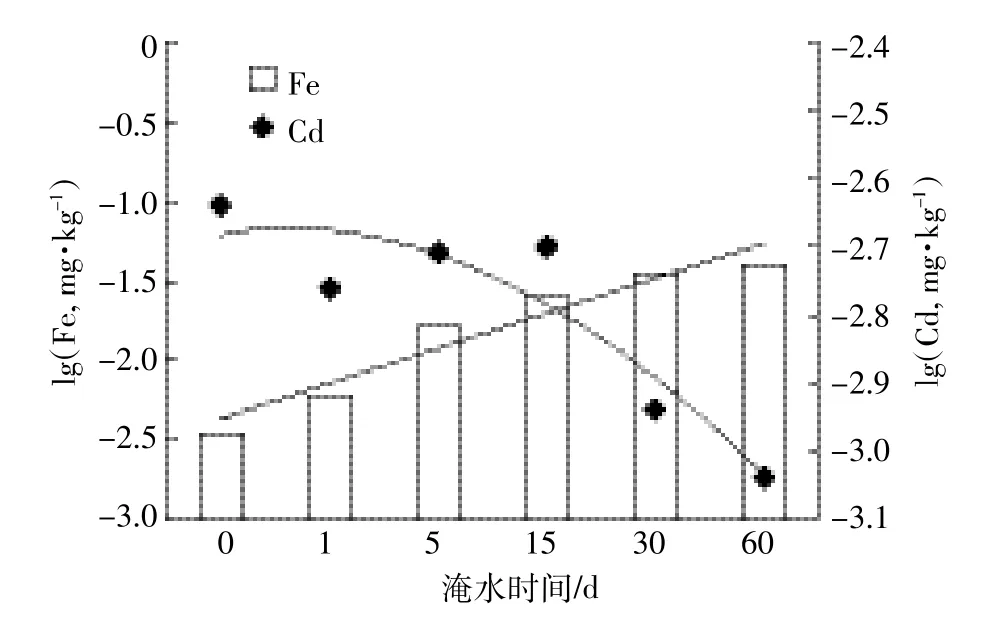
图4 不同淹水时间土壤Fe含量与有效态Cd之间的关系Figure 4 The relations between soil Fe and available-Cd content in different flooding time
总体来看,土壤Fe含量在整个淹水期间持续增加,但增加速率随着淹水时间的延长变得缓慢。土壤有效态Cd含量在淹水1~15 d呈增大趋势,随后开始降低,降低速率同样随着淹水时间的延长变得缓慢。这表明,在淹水15 d后,土壤有效态Cd含量随Fe含量的增加而降低,且变化速率一致,即Fe含量增加速率大时,有效态Cd含量的降低速率也大,Fe含量增加速率降低时,Cd含量的降低速率也小。
3 讨论
淹水后,土壤环境会发生显著的变化,首先在淹水状态下,由于氧的供给被切断,土壤中原有的氧因为微生物呼吸而被消耗殆尽,致使土壤从氧化状态转变为还原状态,因此在淹水无氧环境中土壤的Eh值都会下降[4-5]。与此同时,随着Eh值降低土壤中铁氧化物还原生成新的铁氧化物[6-7],而且淹水后土壤pH值均会趋于中性,与本文研究结果一致。
淹水后,一方面铁锰氧化物溶解生成新的铁锰氧化物会增加土壤对Cd的吸附能力,降低土壤有效态Cd含量[9,13];另一方面,铁锰氧化物溶解会使原先所吸附的Cd释放到土壤溶液中,导致土壤中有效态Cd含量增加[41-43]。一般在碱性土壤(pH>7.5)中粘土矿物结合态及氧化物结合态Cd含量较高[19],淹水使其溶解,Cd释放到土壤溶液中,则可能是碱性土壤在淹水前15 d有效态Cd含量增大的原因。
研究认为,Cd的吸附和解吸过程是控制天然水与土壤间以及土壤中液相和固相Cd分配的主要因子[44-45],有机质作为土壤吸附能的重要组成部分[46],对土壤Cd生物有效性的影响不可忽视。研究表明有机质高的土壤对Cd的吸附能也较强[47],但不同的有机物料对土壤Cd生物有效性影响结果不同,添加牛粪[48]、紫云英和猪粪[49]可显著降低交换态Cd的含量,而施用易分解有机肥[50]和秸秆[51]则提高土壤中Cd的活性和迁移能力。不同的有机物料,在淹水条件下,分解形成的有机质类型不一样,其中DOM(可溶性有机质)的络合作用促进土壤胶体所吸附重金属的溶解,使其释放到土壤溶液中[52-53],而土壤腐殖质的增加却可以降低土壤中重金属的迁移性和有效性。这是因为腐殖质中的胡敏酸和富里酸溶解产出大量能与金属离子发生反应的功能团(-COOH、-OH、-C=O、-NH2、-SH)[54]。这些功能团能与金属离子和金属水合氧化物发生广泛的反应,而且易与粘土、氧化物形成颗粒有机物或有机膜而表现出较大表面积和高度的表面活性,增强了粘土对重金属的吸附,从而降低了Cd的生物有效性[55]。
土壤Eh、pH、铁氧化物、有机质对土壤Cd的吸附-解吸作用是相互的。一方面,淹水后土壤pH值和Eh值的改变,导致铁锰氧化物和有机质的溶解[56],增加土壤对Cd的吸附能;另一方面,铁锰矿物和有机质溶解也会改变土壤pH值和Eh值影响重金属的沉淀-溶解平衡[57]。因此,淹水措施作为土壤Cd污染控制的一种调控手段,还应根据土壤Eh、pH、铁氧化物、有机质等因素的综合影响进一步研究其可行性。
4 结论
(1)不同酸碱性土壤长期淹水后,土壤pH值最终均趋于中性,且Eh值降低、Fe含量增加。有效态Cd含量在酸性土壤中降幅最大且呈持续下降趋势;在中性土壤中虽然在整个淹水期间持续降低,但降幅不大;碱性土壤在淹水15 d有效态Cd含量呈增加趋势,15 d后逐渐减少,淹水30 d后有效态Cd含量才比淹水前有所降低。
(2)中高有机质土壤淹水后,有效态Cd含量降幅最大且呈持续下降趋势;中低有机质土壤淹水后,有效态Cd含量降幅相对较低,在淹水15 d有效态Cd含量降幅最大。
(3)土壤有效态Cd含量随着pH值增大而降低,且变化速率一致,即pH值增加速率大时,有效态Cd含量降低速率也大,反之亦然;土壤有效态Cd含量在淹水前15 d随Fe含量的增加而增加,淹水15 d以后随着Fe含量增加而降低;在整个淹水期间,土壤有效态Cd含量随着Eh值降低而降低。
[1]环境保护部,国土资源部.全国土壤污染状况调查公报[J].中国环保产业,2014(5):10-11.
Environmental Protection Department,Ministry of Land and Resources. National investigation report on soil pollution[J].China′s Environmental Protection Industry,2014(5):10-11.
[2]Sun L,Chen S,Chao L,et al.Effects of flooding on changes in Eh,pH and speciation of cadmium and lead in contaminated soil[J].Bulletin of Environmental Contamination and Toxicology,2007,79(5):514-518.
[3]陈莉娜,葛滢,张春华,等.淹水还原作用对红壤Cd生物有效性的影响[J].农业环境科学学报,2009,28(11):2333-2337.
CHEN Li-na,GE Ying,ZHANG Chun-hua,et al.Effect of submergence on the bioavailability of Cd in a red soil[J].Journal of Agro-Environment Science,2009,28(11):2333-2337.
[4]Reynolds J G,Naylor D V,Fendorf S E.Arsenic sorption in phosphateamended soils during flooding and subsequent aeration[J].Soil Science Society of AmericaJournal,1998,63(5):1149-1156.
[5]Hseu Z Y,Chen Z S.Saturation,reduction,and redox morphology of seasonally flooded Alfisols in Taiwan[J].Soil Science Society of America Journal,1996,60(3):941-949.
[6]Brennan E W,Lindsay W L.The role of pyrite in controlling metal ion activities in highly reduced soils[J].Geochimica et Cosmochimica Acta, 1996,60(19):3609-3618.
[7]Maes A,Vanthuyne M,Caunbery P,et al.Metal partitioning in a sulfidic canal sediment metal solubility as a function of pH combined with EDTA extraction in anoxic conditions[J].The Science of the Total Environment,2003,312(1):181-193.
[8]Kashem M A,Singh B R.Transformations in solid phase species of metals as affected by flooding and organic matter[J].Commmunications in Soil Science and Plant Analysis,2004,35(9/10):1435-1456:
[9]Kashem M A,Singh B R.Metal availability in contaminated soils:Ⅰ. Effects of flooding and organic matter on changes in Eh,pH and solubility of Cd,Ni and Zn[J].Nutrient Cycling in Agroecosystems,2001,61 (3):247-255.
[10]Kitagishi K,Yamane I.Heavy metal pollution in soils of Japan[M]// Heavy metal pollution in soils of Japan.Japan Scientific Societies Press,1981:426.
[11]Gambrell R P,Wiesepape J B,Patrick W H,et al.The effects of pH, redox,and salinity on metal release from a contaminated sediment[J]. Water,Air&Soil Pollution,1991,57/58(1):359-367.
[12]郑绍建,胡霭堂.淹水对污染土壤Cd形态转化的影响[J].环境科学学报,1995,15(2):142-147.
ZHENG Shao-jian,HU Ai-tang.Effects of flooding on the transformation of Cd fractions in contaminated soils[J].Acta Scientiae Circumstantiae,1995,15(2):142-147.
[13]Bolton K A,Evans L J.Cadmium adsorption capacity of selected Ontario soils[J].Canadian Journal of Soil Science,1996,76(2):183-189.
[14]Mustafa G,Kookana R S,Singh B.Desorption of cadmium from goethite:Effects of pH,temperature and aging[J].Chemosphere,2006, 64(5):856-865.
[15]Mustafa G,Singh B,Kookana R S.Cadmium adsorption and desorption behaviour on goethite at low equilibrium concentrations:Effects of pH and index cations[J].Chemosphere,2004,57(10):1325-1333.
[16]Tack F M G,Ranst E V,Lievens C,et al.Soil solution Cd,Cu and Zn concentrations as affected by short-time drying or wetting:The role of hydrous oxides of Fe and Mn[J].Geoderma,2006,137(1):83-89.
[17]Sukreeyapongse O,Holm P E,Strobel B W,et al.pH-dependent release of cadmium,copper,and lead from natural and sludge-amended soils[J].JEnviron Qual,2002,31(6):1901-1909.
[18]郑宏艳,姚秀荣,侯彦林,等.中国土壤模式-作物系统重金属生物富集模型建立[J].农业环境科学学报,2015,34(2):257-265.
ZHENG Hong-yan,YAO Xiu-rong,HOU Yan-lin,et al.Establishment of heavy metal bioaccumulation model of soil pattern-crop system in China[J].Journal of Agro-Environment Science,2015,34(2):257-265.
[19]黄丹丹,葛滢,周权锁.淹水条件下土壤还原作用对Cd活性消长行为的影响[J].环境科学学报,2009,29(2):373-380. HUANG Dan-dan,GE Ying,ZHOU Quan-suo.Effect of redox processes on soil Cd activity under submerged conditions[J].Acta Scientiae Circumstantiae,2009,29(2):373-380
[20]张金洋,王定勇,石孝洪.三峡水库消落区淹水后土壤性质变化的模拟研究[J].水土保持学报,2004,18(6):120-123.
ZHANG Jin-yang,WANG Ding-yong,SHI Xiao-hong.Change of soil character after flooding in drawdown area of Three Gorges Reservoir[J]. Journal of Soil Water Conservation,2004,18(6):120-123.
[21]苏玲.水稻土淹水过程中不同土层铁形态的变化及对磷吸附解吸特性的影响[J].浙江大学学报:农业与生命科学版,2001,27(2):124-128.
SU Ling.Effects of flooding on iron transformation and phosphorus adsorption desorption properties in different layers of the paddy soils[J]. Journal of ZhejiangAgricultural University,2001,27(2):124-128.
[22]高超,张桃林,吴蔚东.氧化还原条件对土壤磷素固定与释放的影响[J].土壤学报,2002,39(4):542-549.
GAO Chao,ZHANG Tao-lin,WU Wei-dong.Effects of redox conditions on the immobilization and release of soil phosphorus[J].Acta Pedolongice Sinica,2002,39(4):542-549.
[23]徐丽娜,李忠佩,车玉萍.淹水厌氧条件下腐植酸对红壤中铁异化还原过程的影响[J].环境科学,2009,30(1):221-226.
XU Li-na,LI Zhong-pei,CHE Yu-ping.Influences of humic acids on the dissimilatory iron reduction of red soil in anaerobic condition[J]. Environmental Science,2009,30(1):221-226.
[24]邵兴华.水稻土淹水过程铁氧化物转化对磷饱和度和磷、氮释放的影响[D].杭州:浙江大学,2005.
SHAO Xing-hua.Effects of iron oxides on phosphorus saturation and nitrogen and phosphorus release in paddy soils during flooding[D].Hangzhou:Zhejiang University 2005.
[25]曹宁.水稻土中铁还原与无机磷有效性的关系研究[D].杨凌:西北农林科技大学,2003.
CAO Ning.Study on the relationship between iron reduction and availability of inorganic phosphorus in paddy soil[D].Yangling:Northwest Agriculture and Forestry University,2003.
[26]胡坤.淹水条件下不同中、微量元素和有益元素对土壤Cd有效性和水稻吸收Cd的影响[D].成都:四川农业大学,2010.
HU Kun.Effects of different medium and trace elements and beneficial elements on the availability of cadmium and cadmium uptake by rice [D].Chengdu:Sichuan Agricultural Uniersity,2010.
[27]单玉华,李昌贵,陈晨,等.施用秸秆对淹水土壤Cd、铜溶出的影响[J].生态学杂志,2008,27(8):1362-1366.
SHAN Yu-hua,LI Chang-gui,CHEN Chen,et al.Effects of straw incorporation on the solubility of cadmium and copper in flooded soil[J]. Chinese Journal of Ecology,2008,27(8):1362-1366.
[28]杨锚,王火焰,周健民,等.不同水分条件下几种氮肥对水稻土中外源Cd转化的动态影响[J].农业环境科学学报,2006,25(5):1202-1207.
YANG Mao,WANG Huo-yan,ZHOU Jian-min,et al.Effects of appling nitrogen fertilizers on transformation of external cadmium in the paddy soil with different soil moisture[J].Journal of Agro-Environment Science,2006,25(5):1202-1207.
[29]朱昌锋.淹水对土壤磷有效性影响的研究[D].成都:西南大学, 2008.
ZHU Chang-feng.Effects of flooding on soil phosphorus availability [D].Chengdu:Southwestern University,2008.
[30]唐罗忠,生原喜久雄,户田浩人,等.湿地林土壤的Fe2+,Eh及pH值的变化[J].生态学报,2005,25(1):103-107. TANG Luo-zhong,Kikuo H,Hiroto T,et al.Dynamics of ferrous iron, redox potential and pH of forested wetland soils[J].ActaEcologicaSinica,2005,25(1):103-107.
[31]许超,林晓滨,吴启堂,等.淹水条件下生物炭对污染土壤重金属有效性及养分含量的影响[J].水土保持学报,2012,26(6):194-198.
XU Chao,LIN Xiao-bin,WU Qi-tang et al.Impacts of biochar on availability of heavy metals and nutrient content of contaminated soil under waterlogged conditions[J].Journal of Soil and Water conservation,2012,26(6):194-198.
[32]甲卡拉铁,喻华,冯文强,等.淹水条件下不同氮磷钾肥对土壤pH和Cd有效性的影响研究[J].环境科学,2009,30(11):3414-3421.
JIA Ka-la-tie,YU Hua,FENG Wen-qiang,et al.Effect of different N, P and K fertilizers on soil pH and available Cd under waterlogged conditions.[J].Environmental Science,2009,30(11):3414-3421.
[33]薄录吉,王建国,王岩,等.淹水时间对水稻土磷素形态转化及其有效性的影响[J].土壤,2011,43(6):930-934.
BO Lu-ji,WANG Jian-guo,WANG Yan,et al.Effect of flooding time on phosphorus transformation and availability in paddy soil[J].Soils, 2011,43(6):930-934.
[34]王桂风,刘凌,田娟.淹水过程不同土层磷的释放研究[J].环境科学与技术,2008,31(12):21-23.
WANG Gui-feng,LIU Lin,TIAN Juan.Phosphorus release in different layers of flooded soils[J].Environmental Science&Technology,2008, 31(12):21-23.
[35]刘贝贝.重金属对水稻土中异化铁还原的影响[D].杨凌:西北农林科技大学,2006.
LIU Bei-bei.Effects of heavy metals on iron reduction in paddy soils [D].Yangling:Northwest Agriculture and Forestry University,2006.
[36]Zhu Q H,Huang D Y,Liu S L,et al.Flooding-enhanced immobilization effect of sepiolite on cadmium in paddy soil[J].Journal of Soils and Sediments,2012,12(2):169-177.
[37]施林林,陆长婴,王海候,等.水分管理对太湖地区水稻土无机磷转化的影响[J].江西农业学报,2012,24(8):1-5.
SHI Lin-lin,LU Chang-ying,WANG Hai-hou,et al.Effect of water management on transformation of inorganic phosphorus in paddy soil in Taihu Lake district[J].ActaAgriculturae Jiangxi,2012,24(8):1-5.
[38]王图锦,吉芳英,何强,等.三峡库区土壤铁异化还原及其对铁形态影响[J].重庆大学学报,2011,34(1):100-104.
WANG Tu-jin,JI Fang-ying,HE Qiang,et al.Dissimilatory iron reduction processes of soil from Three Gorges Reservoir area and its effect on chemical form of Fe[J].Journal of Chongqing University,2011, 34(1):100-104.
[39]杨长明,杨林章,颜廷梅.不同养分和水分管理模式对土壤生态环境影响[J].生态与农村环境学报,2002,18(3):11-15.
YANG Chang-ming,YANG Lin-zhang,YAN Ting-mei.Effects of nutrient and water regimes on paddy soil eco-environment[J].Rural Ecoenvironment,2002,18(3):11-15.
[40]吉芳英,王图锦,叶姜瑜,等.三峡库区土壤淹水对Cd形态稳定性的影响[J].土木建筑与环境工程,2012,34(2):115-120.
JI Fang-ying,WANG Tu-jin,YE Jiang-yu,et al.Effect of submerged condition on chemical form of Cd in soil of three gorges reservoir area [J].Journal of Civil Architectural&Environmental Engineering,2012, 34(2):115-120.
[41]Chuan M C,Shu G Y,Liu J C.Solubility of heavy metals in a contaminated soil:Effects of redox potential and pH[J].Water,Air&Soil Pollution,1996,90(3):543-556.
[42]Davranche M,Bollinger J C.Heavy metals desorption from synthesized and natural iron and manganese oxyhydroxides:Effect of reductive conditions[J].Journal of Colloid&Interface Science,2000,227(2):531-539.
[43]Davranche M,Bollinger J C.Release of metals from iron oxyhydroxides under reductive conditions:Effect of metal/solid interactions[J].Journal of Colloid&Interface Science,2000,232(1):165-173.
[44]Gardiner J.The chemistry of cadmium in natural water:Ⅱ.The adsorption of cadmium on river muds and naturally occurring solids[J]. Water Research,1974,8(3):157-164.
[45]Santillan-Medrano J,Jurinak J J.The chemistry of lead and cadmium in soil:Solid phase formation[J].Soil Science Society of America Journal,1975,39(5):851-856.
[46]杜彩艳,祖艳群,李元.pH和有机质对土壤中镉和锌生物有效性影响研究[J].云南农业大学学报,2005,20(4):539-543.
DU Cai-yan,ZU Yan-qun,LI Yuan.Effect of pH and organic matter on the bioavailability Cd and Zn in soil[J].Journal of Yunnan Agricultural University,2005,20(4):539-543.
[47]焦文涛,蒋新,余贵芬,等.土壤有机质对Cd在土壤中吸附-解吸行为的影响[J].环境化学,2005,24(5):545-549.
JIAO Wen-tao,JIANG Xin,YU Gui-fen,et al.Effects of organic matter on cadmium adsorption-desorption in three soils[J].Environmental Chemistry,2005,24(5):545-549.
[48]Zeng F R,Ali S,Zhang H T,et al.The influence of pH and organic matter content in paddy soil on heavy metal availability and their uptake by rice plants[J].Environmental Pollution,2011,159(1):84-91.
[49]Song J,Guo Z H,Xiao X Y,et al.Environmental availability and profile characteristics of arsenic,cadmium,lead and zinc in metal-contaminated vegetable soils[J].Transactions of Nonferrous Metals Society of China,2009,19(3):765-772.
[50]Pérez-De-Mora A,Madejón E,Burgos P,et al.Trace element availability and plant growth in a mine-spill contaminated soil under assisted natural remediation:Ⅰ.Soils[J].Science of the Total Environment, 2006,363(1/2/3):28-37.
[51]Liu C C,Chen G B.Reclamation of cadmium-contaminated soil using dissolved organic matter solution originating from wine-processing waste sludge[J].Journal of Hazardous Materials,2013,244/245:645-653.
[52]Fotovat A,Naidu R.Changes in composition of soil aqueous phase influence chemistry of indigenous heavy metals in alkaline sodic and acidic soils[J].Geoderma,1998,84(1/2/3):213-234.
[53]Hesterberg D,Bril J,Castilho P D.Thermodynamic modeling of zinc, cadmium,and copper solubilities in a manured,acidic loamy-sand topsoil[J].Journal of Environmental Quality,1993,22(4):681-688.
[54]Sposito G,Weber J H.Sorption of trace metals by humic materials in soils and natural waters[J].Critical Reviews in Environmental Science and Technology,1986,16(2):193-229.
[55]余贵芬,蒋新.有机物质对土壤Cd有效性的影响研究综述[J].生态学报,2002,22(5):770-776.
YU Gui-fen,JIANG Xin.A review for effect of organic substances on the availability of cadmium in soils[J].Acta Ecologica Sinica,2002,22 (5):770-776.
[56]王浩,章明奎.有机质积累和酸化对污染土壤重金属释放潜力的影响[J].土壤通报,2009,40(3):538-541.
WANG Hao,ZHANG Min-kui.Effects of organic matter accumulation and acidification on release potential of heavy metals from polluted soils[J].Chinese Journal of Soil Science,2009,40(3):538-541.
[57]Liu C C,Lin Y C.Reclamation of copper-contaminated soil using EDTA or citric acid coupled with dissolved organic matter solution extracted from distillery sludge[J].Environmental Pollution,2013,178:97-101.
Effects of pH,Eh,Fe,and flooded time on available-Cd content after flooding of different kinds of soil
ZHU Dan-mei1,LIU Yan1,ZHANG Li1,2,WANG Xiu-mei1,AN Yi1,LI Yu-jin1,LIN Da-song1*
(1.Agro-Environmental Protection Institute,Ministry of Agriculture,Tianjin 300191,China;2.College of Resource and Environment,Northeast Agricultural University,Harbin 150030,China)
Based on collected and arranged data,the following variables were assessed after flooding:the trend in the change of soil pH values,Eh values,Fe(Fe(Ⅱ)and amorphous iron oxide)content,and available Cd content under different pH values in southern soil;the trend in the change of available Cd content in soil with different organic matter contents;and the effect of the trend in the change of pH,Eh, and Fe on the content of available Cd in soils.Several conclusions were drawn based on these analyses.All pH values tended to be neutral, the Eh decreased,and the Fe content increased in three kinds of soil with different pH values after 60 days of flooding.The content of available Cd in acid and neutral soils showed a continuous decreasing trend,decreasing 42%and 38%,respectively.In alkaline soil,it decreased 27%,and it increased on the first 15 days of flooding and then decreased gradually.In soil with different organic matter content after flooding,the content of available Cd in the soil with medium-high organic matter(≥20 g·kg-1)showed a continuous decreasing trend and decreased 78%.In the soil with medium-low organic matter(≤20 g·kg-1),it decreased 52%and increased on the flooded 15~30 days;the content of available Cd in the soil with the 15-day flooded treatment was lower than that for the 60-day treatment.After flooding,the content of available Cd in soil decreased with the increase in pH value,and the change rate was consistent;when the increase rate of the pH value increased,the decrease rate of the content of available Cd also increased,and vice versa.The content of available Cd in soil increased withthe increase in the Fe content on the first 15 days of flooding,and then decreased with increase in Fe content.The content of available Cd decreased with the decrease in the Eh value during the flooding.In conclusion,the content of available Cd in soil could be effectively reduced in acid soil and medium-high organic soil after flooding.In alkaline soil,the available Cd content could only be reduced by flooding of not less than 30 days.In the medium-low organic soil,flooding should be conducted for less than 15 days in order to reduce the content of available Cd in soil.
pH;Eh;Fe;available Cd;flooding
X53
A
1672-2043(2017)08-1508-10
10.11654/jaes.2016-1491
2016-11-23
朱丹妹(1992—),女,安徽宿州人,硕士研究生,研究方向为农业资源与利用。E-mail:zdmyam@163.com
*通信作者:林大松E-mail:lindasong608@126.com
国家自然科学基金项目(31200397)
Project supported:The National Natural Science Foundation of China(31200397)
朱丹妹,刘岩,张丽,等.不同类型土壤淹水对pH、Eh、Fe及有效态Cd含量的影响[J].农业环境科学学报,2017,36(8):1508-1517.
ZHU Dan-mei,LIU Yan,ZHANG Li,et al.Effects of pH,Eh,Fe,and flooded time on available-Cd content after flooding of different kinds of soil[J].Journal of Agro-Environment Science,2017,36(8):1508-1517.
